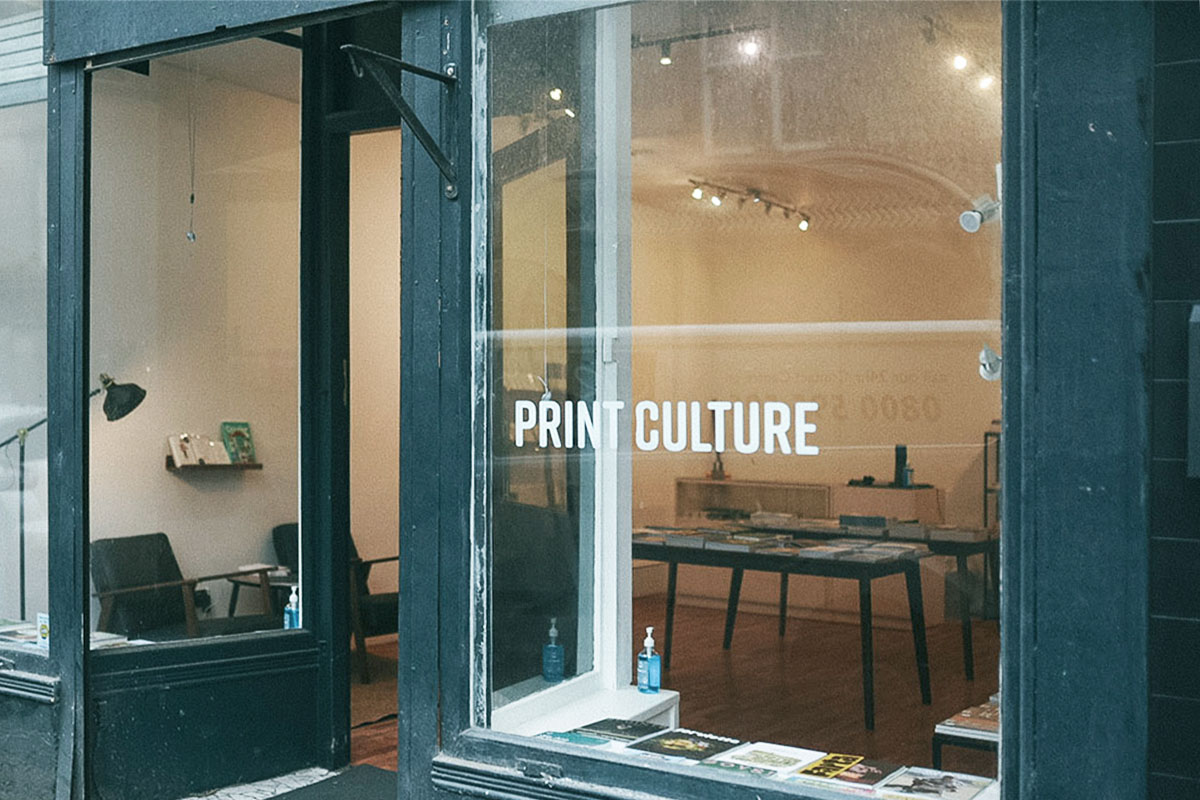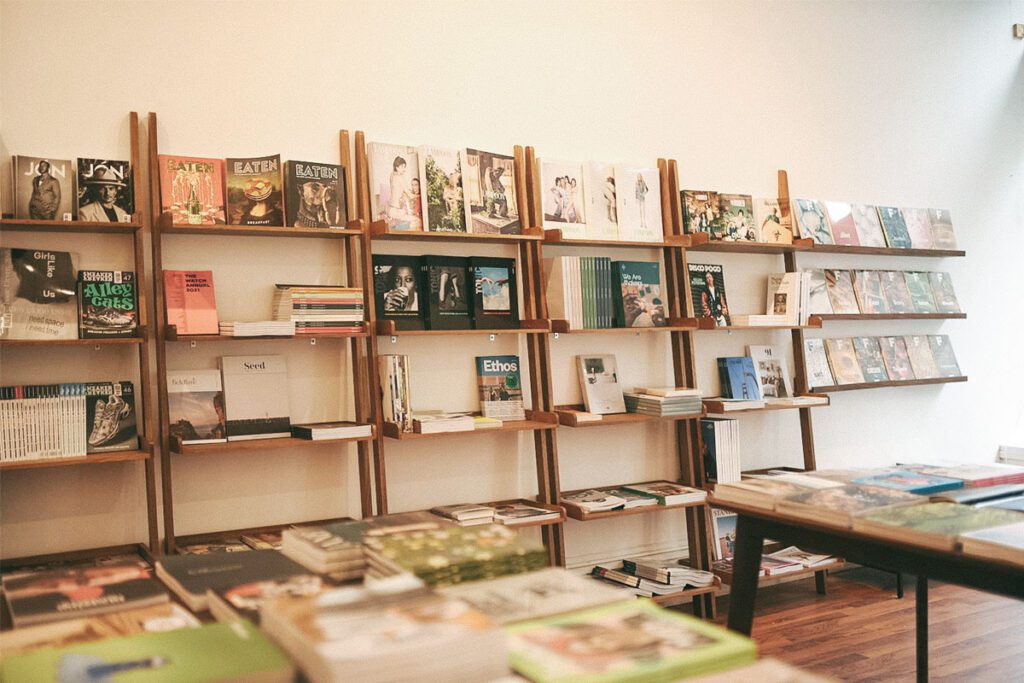Selling niche stationery and independent magazines that hone in on micro-cultures and coterie drawn to certain cities, tastebuds or vocations, Print Culture is Glasgow’s newest resident
A Print Culture retail transformation
Print Culture is Glasgow is selling niche stationery and independent magazines that hone in on micro-cultures and coterie drawn to certain cities, tastebuds or vocations. The store soft-launched in September 2022, but it was down to a mix of a life-long affection for printed matters – books, magazines, and all that supports its creation: pens, pencils, planners – curiosity and entrepreneurship.
This led Nicholas Chester-Adams to the launch of a long-time considered passion project, Print Culture. «Primarily I have worked for supermarkets and fast fashion retailers managing their transformations. I did that for twenty years», says Chester-Adams. For the Glasgow local, two decades in the retail space has been enough to inspire entrepreneurship. «A couple of years ago, I decided it was time to do it for myself. Instead of managing the transformations of other businesses, I wanted to run the retail business. That is how we got into talking about opening a store». The we Chester-Adams refers to is his wife, Lisa, who now manages the shopfront by his side.
Glasgow as a hub for traditional newsstands
For Chester-Adams, the realization that there was an opportunity in Glasgow was the result of years of travel. «Through work, I have traveled around the world, and one thing that we always found lacking here in the UK market were traditional newsstands». In comparison to European or American equivalents, Chester-Adams attests, «We do have newsagents, but we do not have many American or European newsstands – the kind that sells more specialist or unusual magazines».
The store is set on a Glaswegian street locally dubbed ‘Shoreditch of Glasgow’, nodding to one of London’s trendy areas. It is a hive of university students, creatives, and young and mature professionals who share a similar penchant for the subject of independent magazines. It is surrounded by art galleries, barbers and hairdressers, retail stores and hipsters. To Chester-Adams, this diversity of demographic enables him to offer stocks to myriad customers. «We see people in the design community coming into the store. There are students across broad subjects from design and art to architecture and history».
Print Culture as a window into Chester-Adam’s personal taste book
Print Culture is effectively a window into Chester-Adam’s personal taste book as a self-confessed magazine lover, but this is starting to change as the store and stock evolve and expand. «We have started to take more delivery of LGBTQ+ magazines, so we are trying to grow that side of our inventory. We have taken on a back collection of Elska Magazines. Again, in that space, we are looking at those who are slightly unusual in their take on a subject. Elska, for example, fits with our passion for travel, as they focus on a gay scene in a particular city in each issue».
Diversity in relation to the stock of the Print Culture does not stop there. Chester-Adam foresees it offering titles for everyone in the long run. A range of languages will be key to unlocking the full potential of the store and making Print Culture a one-stop shop for independent titles from around the world. «We have in stock a couple of bilingual magazines, and we are looking to bring in a few more languages. We are lucky that our city has a large student population, so we have an interest. Here we have some German language magazines, and we will continue to grow this offering».
The curatorial process at Print Culture
As for how the curation process is conducted, it all stems back to social media, mostly Instagram, as a source of intel. «This is where most of these independent magazines are», says the shop owner, «but there’s also a community around these styles of magazines – the likes of Mag Culture and Over the Leaf that are out there pushing Independent print magazines».
A driver of business for the duo remains not in the present but in past issues. «When we are going for a magazine, we try to get as many past issues as possible. Often, we find in this particular space that our customers are not necessarily looking for the latest issue, they are looking for a back issue with a particular subject or topic that was in it. Some people are collectors, they want the latest issue, but then there are those that are more specific on an issue for a reason».
More than magazines
Currently, still in its infancy, Print Culture represents one hundred and twenty five individual and independent publishers but strives to double that in the future. Aside from the magazines, there is more to draw-in either avid followers of the subject or passersby. The shop is home to a hoard of niche stationery brands from around the world. «We are an authorized dealer of the Kaweco fountain pens – the sport pen, as they call it – and we have Blackwing pencils, too. They come with the Moleskin history behind them. These were the pencils used by the illustrators who would have drawn the Looney Tunes in the beginning».
Striving to find a balance between the old-sung hero brands and pioneering rookies, Chester-Adam’s balances the heritage brands with new kids on the block, such as the Australian productivity-based stationery brand, MiGoals. Although a considerably new brand, in comparison to some of its neighboring products, Chester-Adam says, «they have proven quite successful».
A tree per product at Print Culture
There are those with sustainability charters which do not go amiss. «We also have one brand where the paper is made out of stone instead of using trees. They are good and popular. We have the more standard style Rhodia notebooks». For Chester-Adam, sustainability is a directive for everyday decision-making, but the nature of the business does pose challenges in this respect. «One of the things that we are aware of is that we import magazines from around the world. There is no hiding that this is not the best thing for the planet. Hence why we have started an initiative where for every item we sell, we plant a tree. For things like the mileage that it takes to drive to and from the store, we offset that through our plant a tree initiative».
Striving to partner with ethical and sustainable businesses or those who share similar principles is a priority. «From a manufacturing perspective, we work with people with a similar mindset to this. They usually use recyclable systems, part-cyclable systems or at least growing a cyclical production system and using more environmental alternatives».
The environmental interior design perspective
«Everything in the store from a design perspective follows the same thread. The shelving is natural wood veneer and the veneers are recycled American walnut». From a cost perspective to fit the store out as a team of just two, the husband-and-wife duo prescribed four weeks for the transformation. «We wanted to work with someone, a designer or architect, and bring them in on the project. Ideally, we would have had Vitsoe-style shelving, but ultimately it is a start-up, and this would have priced us out. We went fairly straightforward with walnut mid-century shelving, designed to allow the magazines to be displayed like art rather than your traditional stacked-up newsagent agents or bookstand».
Beginning with a blank white space, Chester-Adam says, «We were lucky that the shop itself was a white box with a decent floor, so we did not have to do tons of prep work in order to get it where it needed to be».
Aside from a handful of furniture, the space remains focused on the main attraction – the stock. «We added shelves along one side of the wall, a few large tables with magazines on them, some mid-century armchairs and coffee tables for people to sit and have a read of something». The ‘something’ is what Chester-Adam calls shop copies – coffee table books, art books, collections of photographs. Some publishers, he explains, are less keen on selling through the store. Instead, they are focused on getting their name out there and generating brand awareness. In these instances, Print Culture will have a few of them laid out so that customers can browse them in the store at ease and decide to purchase from them directly if they choose to.
The future of Print Culture
It is not a library, but it is a gathering space of sorts, and the owners intend on growing this side of its identity. «Long-term, we would like to be an inclusive space where anyone can come and feel safe and welcome and be able to purchase materials that they are looking for and we will have events and activities going on within the store», says Chester-Adam.
On consideration, he says that the twosome began this venture with little expectation and that they will stay dedicated to their local, humble roots for the time being. «Ideally, we would like to stay local in the medium term. If we felt there was another city with the right energy, we may consider it – if there were nothing else there currently in that market. Right now, many of those other suitable cities already have a shop in that space, and we would not want to come into someone else’s market».
Print Culture Glasgow
23 Parnie Street, Glasgow, Scotland.
Print Culture is an independent magazine and stationery shop, located in Glasgow, Scotland.




















